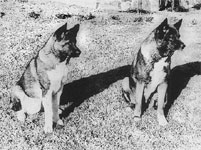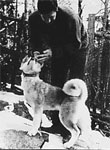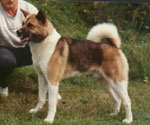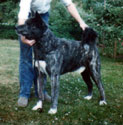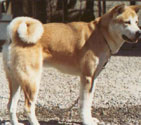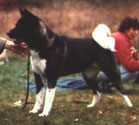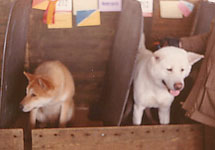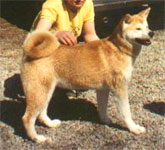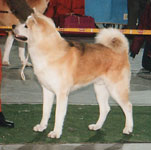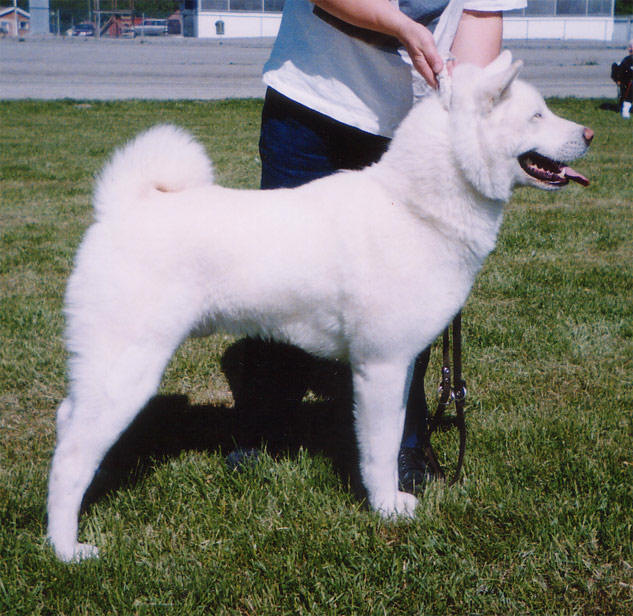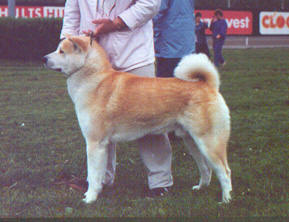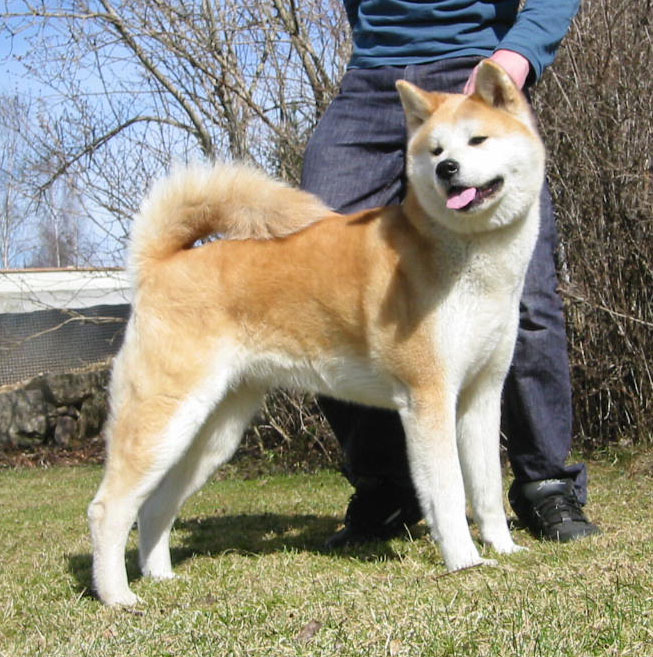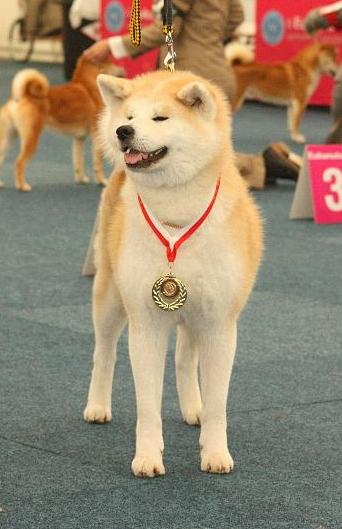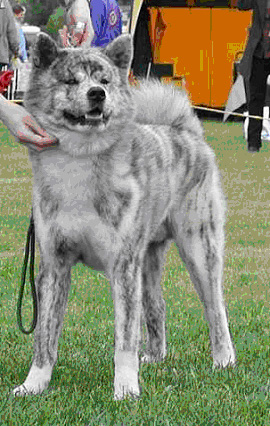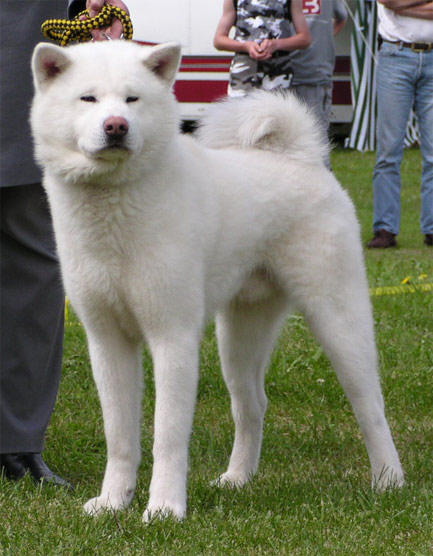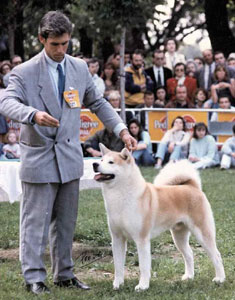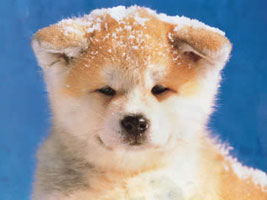|
Sweden and Norway
The Norwegians
were
probably introduced to the Akita breed for the very first time in April 1966
when the Swedish male ”Nero”, born in 1962 in Japan, became Best in Show at
NKK’s International Show in Sjølyst. He was a magnificent dog with a proud
presence who took the breath away from many of the spectators when he was
exhibited in the typical Japanese leash with a tassel.
Up until 1985 we had a joint Club in Norway and Sweden for the Akita but by now the population of Akitas had increased in Norway and it was time to establish our own Club, Norsk Akita Klubb (NAK). The Swedish/Norwegian co-operation concerning breed related issues continued as before. NAK arranged their first exhibition in Gudbrandsdalen in 1985 and 40 Akitas were exhibited. Due of the little information that existed about the breed at that time it was eg. long believed that an Akita should have wrinkled foreheads, wrinkles that disappeared when he relaxed. The information we had came mainly came from the US and from American books on the Akita, and there they had wrinkled foreheads. For many years there existed no exchange of information with Japan so it was a bit difficult to try to imagine what the breed looked over there. It wasn’t until the late 80’s when breed enthusiasts began to travel to shows in Europe that we started receiving information about the breed and were able to see the enormous development the breed had gone through since the first imports came to our country. An exhibition was held in 1990 at Hellerudsletta and the breed then was judged by Akita breeder/judge/JKC contact Mr. Shinja Kuroki from Japan. His general impression of the breed in Norway/Sweden was ”good bodies – chop off the heads!” – he was probably came from a samurai family… In Norway the Akita is mainly used as a combined companion dog. There has been an avalanche rescue dog, a couple of agility dogs and a few that compete in different Obedience Classes, but mainly the breeds tracking qualities have been cherished and the Akita has been proven to be very suited as a game tracker as well as a tracking dog for wounded game. He is superbly qualified to this type of work as he has a couple of excellent qualities: he is very thorough, calm and quiet during his tracking work.
After the split
in January the1st in 2000 the Akita in Norway once again became a numerically
small breed and the population decreased to approximately 150 individuals (to be
compared with 1993 when we had nearly 750 Akitas!). Due to our quarantine
restrictions it hasn’t been an easy task to import new dogs. The possibilities
exist with the open borders for dogs vaccinated against rabies and it is, in
theory, possible to travel to Europe with bitches in heat to expecting males,
but the possibility hasn’t been practiced in reality.
In the early 70’s, in addition to Sakura-Hime, three more dogs from Japan arrived. There were some serious discussions in those days when the first Akitas of the ”modern” type arrived to Sweden in the 70’s. Some people could not believe that what they saw where “true” Akitas but that they had to mixed with Shibas!
In 1978 Nero’s and Sakura’s son, Chibata-Hima, became nr 2 in SKK’s “Golden dog Competition” and the breed received a lot of attention and the register numbers began to increase, for better and worse. Akita Inu Sällskapet (AIS) was officially established in 1980 but had been active since 1976. At that time the breed was considered to be “Swedish/Norwegian” and AIS acted as a joint Club for both countries with joint exhibitions every year and a breed council. The first exhibition, arranged by AIS, was in the outskirts of Stockholm in 1980 and 22 dogs were exhibited. .
Due to the exchange of breeding material with Sweden through the years, including that a couple of imported males had been over used who later on proved to be carriers of an autoimmune disease called Sebacious Adenitis Folicularis (or SA) and, seen as a whole, it has become a very narrow Swedish/Norwegian breed to work with. So, we were almost at a fresh start but, since the split, hard work and new bloodlines have helped us.
The Akita around the World
A male that really stood out during the 90’s was the italian/american Richard
Hellman’s Japanese import ”Seihoh of Juntaidoh”. He received this male in
exchange for 1 kg of Parmesan cheese!
I hope that in a near future that it will become easier to import dogs to Norway who can contribute to the development of the breed. And that the research project going on the SA, staged by the WUAC, hopefully will find the answer to the SA problem which will widen the possibilities to find potential breeding material within the breed. In addition, several have taken an interest in the breed and it’s background as a ”matagi-inu” and the possibilities to use it as a game tracker and a tracking dog for wounded game, the Akita is on it’s way back and the future for the breed looks bright.
References: 1. Hiroshi Saito, (Hirokichi, Kokichi) et. al., "Zadankai: Nihoninu Wo Enryonaku Kataru (Symposium: A Candid Discussion On Japanese Dogs)," Aiken No Tomo, p. 44-50, april 1954, Seibundo Shinkosha, Tokyo, Japan. 2. Richard Storry, “Japan”, 1965. 3. F. Junko, “The Dogs of Japan”, published in “The East”, Vol.8 nr.3, March 1972 4. Joan M. Linderman og Virginia Funk, “The New Complete Akita”, 1983 5. Robert von Sander “Personligheter och händelser under 1000 år i Japan”, part 1. in a series of lectures about the Samuraiculture at the Ethnographic Museum in Stockholm in connection with the exhibition “Japan-Living Tradition”, 1984 6. Keiichi Ogasawara DVM, Odate, Akita, Japan “The Akita Dog and It’s Origin” ("Akitainu To Sono Yurai") published in “Studies of The Natural Environment and Culture of The Prefecture of Akita,” special edition, “The Akita University Research Bulletin”: p.101-116, 1987. 7. Mutsuo Okada, “The Akita Dog’s Roots in Southern Japan”, published in the Akita Journal 1980 - 1981 and the Akita World 1994 – 1995, and translated by Tatsuo Kimura, AKIHO
8.
Hiroshi Kamisato, WUAC/JKC, Japan |
||||||||||||||||||||||||||||||||||
